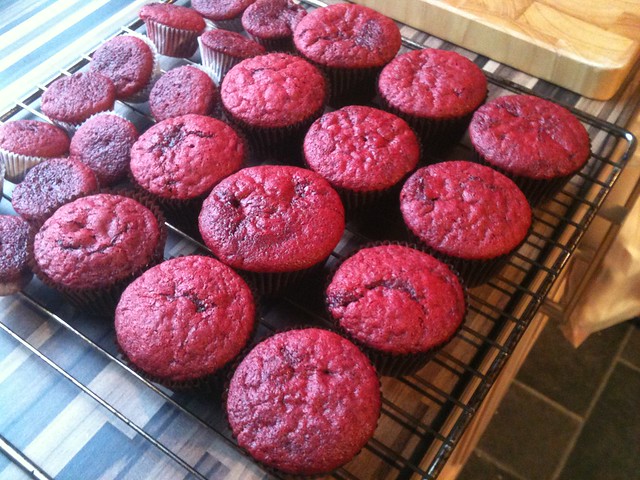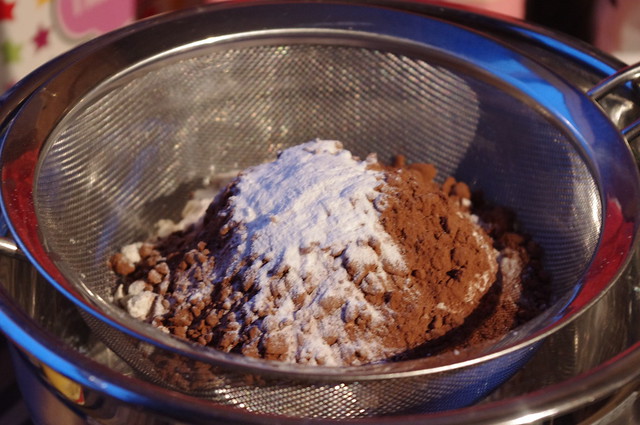This weekend was the annual Bradford Beer Festival. One of the highlights of my year. Local friends and London friends all descend upon Saltaire to sample the finest beers that the UK breweries have to offer. To mark the occasion I decided to bring a pie. A pork pie. I've been obssessing over making my own pork pie for weeks and decided that it would be perfect to bring one along with me.
 |
| Beer + Pie = Perfect combination! |
There was something really enjoyable about the whole process. The making of the soft, tactile pastry and the meticulous chopping of the meat. This pie needs time, I made it over 2 days...but you will be rewarded, and I highly recommend you try it.
It was bigger than anticipated but it did really well in feeding around 12-15 people - washed down with beer it was amazing.
The recipe comes from Hugh Fearnley Whittingstall's River Cottage Meat book, on page 444.
Hugh's Pork Pie
Ingredients
For the pastry:
550g plain flour
100g butter
100g lard
200ml water
2 eggs
1 1/2tsp salt
For the filling:
1kg pork shoulder - chopped into 5cm dice (takes time and a sharp knife is a must!)
250g streaky bacon - chopped finely
250g pork belly - minced. I whizzed it up in the food processor
2 large sprigs of thyme, finely chopped
12 sage leaves, finely chopped
1tsp salt
1tsp black pepper
1tsp white pepper
1/2tsp mace
A pinch of cayenne pepper
For the jelly
200ml chicken stock
1x 15g sachet powder gelatine
Melt the butter and lard together in the pan, with the water. While the fats are melting, mix 550g of plain flour and one and a half teaspoons of salt together in a large bowl, form a well in the flour and then break two eggs into the bowl. Mix the eggs into the flour slightly and then slowly pour in the fat and water, mixing all the time. I used my mixer and a dough hook, but can easily be done my hand.
The dough will come together. You may need to add more flour or water, depending on whether it feels too sticky or dry. the dough will be very soft and pillowy! Briefly knead the dough, then wrap it in clingfilm and let it rest in the fridge for an hour or so.
For the filling, mix all of the ingedients thoroughly in a large bowl. The reason for the different cuts of meat is for texture, the shoulder provides a "meaty" texture, the bacon flavour and the belly provides much needed fat, and also act as a glue for the meat mixture.
Now to assemble the pie. Cut off about a third of the pastry and put it to one side for the lid, then roll out the rest into a large round, appox 1cm thick. Slide the pastry into a greased cake tin with a loose base and press it down so that the pastry reaches the top of the tin. I used an 18cm cake tin with high sides, the original recipe asks that you use a 20cm tin. so if you use a 20cm, then make sure the pastry reaches approx 3/4 up the sides. By using a spring form tin with a clip on the side will make the ‘getting the pie out’ operation much simpler.
Now, getting the pastry into the tin seems much simpler than it sounds - the pastry is very soft a slippery and it will try to fall down, be vigilant and confident with it. Make sure there are no holes in the pastry walls.
Then fill the casing with the filling. Really cram it in until it can't take any more. Remember, the pie filling will shrink up on cooking.
The roll out the remaining pastry into a lid and crimp it onto the top of the pie - make sure you use a beaten egg to seal the lid, as it is the only thing strong enough to keep everything in the pastry. For an extra bit of decoration I cut out a couple of leaves from the leftover pastry. Make sure you also cut a 1cm hole in the middle of the lid for steam to escape.
 |
| Ready for the oven |
Then you'll need to wait for the pie to cool before adding the jelly. Probably an hour or so, but as it was 11pm by the time the pie came out of the oven, I left it to cool overnight, then put it in the fridge until the evening.
The recipe details stock made from pigs trotters, boiling them down for a couple of hours. I didn't really have the time, so I bought a tub of ready made fresh chicken stock, heated it up gently and dissolved the gelatine into it.
Once the jelly is ready, you'll need to pour it into the hole - use a turkey baster if you have one - I poured it in using a measuring jug. Pour it in slowly, giving it time to settle in the pie, filling in the cavities left by the shrunked meat. Pour it in until you can't fit in any more.
 |
| Filled with jelly |
Once the pie is filled refrigerate, until the jelly is set - ideally overnight but it should be ready after 5 hours.
The pie will keep in the fridge for about 2 weeks - I think the next time I make it I might add in a few boiled eggs. If you don't want to make a huge pie, then you could make individual pies by lining a muffin tin. After the first 30 minutes of cooking time, take them out, brush with egg and cook for a further 25 minutes.
 |
| Thanks Hugh! |















































